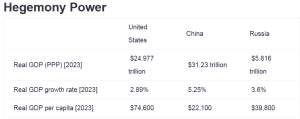Hegemony Power
| United States | China | Russia | |
| Real GDP (PPP) [2023] | $24.977 trillion | $31.23 trillion | $5.816 trillion |
| Real GDP growth rate [2023] | 2.89% | 5.25% | 3.6% |
| Real GDP per capita [2023] | $74,600 | $22,100 | $39,800 |
| Military expenditures (% of GDP) [2023] | 3.2% | 1.5% | 5%: Hegemony Power |
| Active-duty military personnel | 1.31 million | 2 million | 1.3 million |
| Total area (sq. km.) | 9,833,517 sq km | 9,596,960 sq km | 17,098,242 sq km |
| Total population | 341,963,408 | 1,416,043,270 | 140,820,810 |
| Education expenditures (% of GDP) | 6.1% | 3.6% | 3.7% |
According to Pevehouse and Goldstein (2017), hegemony refers to a state wielding significant power in the international system, allowing it to single-handedly dictate rules and arrangements by which political and economic relations between countries are run. The US was more powerful in the late 1940s when its military power and economy dominated the rest of the world. For instance, the United States’ GDP at the time was more than half of the world’s combined GDP. On the military front, the US was dominant because it could defeat its rivals even if they combined forces due to its nuclear power.
However, the data above indicates that the US is losing its standing as a global hegemon. In terms of the economy, China has experienced significant growth such that its GDP ($31.23 trillion) has overtaken the US ($24.977 trillion) (CIA, 2023). Although the United States’ per capita GDP is way higher, China’s real GDP growth is higher, indicating that China continues to gain momentum.
Besides, China has a higher population (1,416,043,270) than the US (341,963,408), which implies that China has a higher market power (CIA, 2023). When it comes to military power, China has increasingly become militarized, with its active military personnel exceeding the two million mark. On the other hand, the US has about 1.3 million active military personnel.
Another key indicator of a country’s hegemony power is the purchasing power parity. Although related to the market size, the purchasing power is different since it depends on the disposable income of the citizens of a country. In financial terms, it can be determined by the GDP per capita of a nation. Based on the data above, the US has the highest GDP per capita ($74,600), followed by Russia ($39,800), and then China ($22,100).
Based on these figures, the US has the population with the highest GDP per capita, and this is perhaps the reason why the country still enjoys hegemony power. The United States’ relatively smaller and productive population means that more people are participating in the formal economy and making money compared to China which has a higher GDP. China’s population is four times that of the US; hence more people who purchase industrial goods.
In terms of military spending, the US is losing to Russia. Whereas the US spends 3.2% of its GDP on its military, Russia spends 5% of its GDP on its military, an indication of the willingness to invest more resources in the military (CIA, 2023). The huge military expenditure has helped Russia acquire advanced military weaponry; hence can sustain its rivalry with US. Due to the strong military, Russia today undertakes military action even without the US’s approval; implying that the US has lost the monopoly of violence it used to pride itself in.
Based on the insights above, China is likely to overtake the US as the world’s dominant power. A key contributor that will drive China to the top is its huge population which provides a ready market for its industrial products.
Also, China’s statecraft, economic policy, and skillful diplomacy have led to it becoming attractive as a partner, unlike the US, which is considered overbearing (Thi Thuy, 2020). Besides, the US faces significant local problems such as overspending, overconsumption, and low savings (Thi Thuy, 2020). To that end, the durability of US hegemony will depend on how it confronts the challenges it faces.
References
CIA. (2023, November 30). The World Factbook. CIA.gov. https://www.cia.gov/the-world-factbook/
Pevehouse, J. C., & Goldstein, J. S. (2017). International relations (7th ed.). Pearson Education.
Thi Thuy, H. N. (2020). The United States: Still a global hegemonic power? Journal of International Studies. https://doi.org/10.32890/jis.8.2012.7924
ORDER A PLAGIARISM-FREE PAPER HERE
We’ll write everything from scratch
Question 
| Instructions | |||||||||||||||||||||||||||||||||||||
Students will submit an essay in response to the following prompts.
|
|||||||||||||||||||||||||||||||||||||

Hegemony Power
